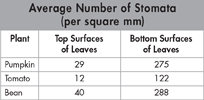Standardized Test Prep
Multiple Choice
Which of the following cell types is NOT found in a plant's vascular tissue?
tracheid
vessel element
guard cell
companion cell
Where in a plant does mitosis produce new cells?
meristems
chloroplasts
mesophyll
heartwood
Which tissues make up tree bark?
phloem
cork
cork cambium
all of the above
Which is NOT a factor in the movement of water through a plant's vascular tissues?
transpiration
capillary action
osmotic pressure
meristems
All of the following conduct fluids in a plant EXCEPT
heartwood.
sapwood.
phloem.
xylem.
Where does most of the photosynthesis occur in a plant?
stomata
guard cells
vascular cambium
mesophyll tissue
Which of the following structures prevents the backflow of water into the root cortex?
palisade mesophyll
root cap
cambium
Casparian strip
Which of the following plants has a fibrous root system?
dandelion
beet
radish
grass
Questions 9–10
A student compared the average number of stomata on the top side and the underside of the leaves of different plants. Her data are summarized in the table below.
What generalization can be made based on the data?
All plants have more stomata on the top side of their leaves than on the bottom side.
Plants have fewer stomata on the top side of their leaves than on the bottom side.
Some plants have more stomata on the top side of their leaves than on the bottom side.
The number of stomata is the same from plant to plant.
Pumpkins, tomatoes, and beans all grow in direct sunlight. Assuming the plants receive plenty of water, stomata on the lower surface of their leaves
are always closed.
are usually clogged with dust.
are unlikely to close at night.
stay open during daylight hours.
Open-Ended Response
Contrast the functions of xylem and phloem.
| Question | 1 | 2 | 3 | 4 | 5 | 6 | 7 | 8 | 9 | 10 | 11 |
|---|---|---|---|---|---|---|---|---|---|---|---|
| See Lesson | 23.1 | 23.1 | 23.3 | 23.5 | 23.3 | 23.4 | 23.2 | 23.2 | 23.4 | 23.4 | 23.5 |
Table of Contents
- Formulas and Equations
- Applying Formulas and Equations
- Mean, Median, and Mode
- Estimation
- Using Measurements in Calculations
- Effects of Measurement Errors
- Accuracy
- Precision
- Comparing Accuracy and Precision
- Significant Figures
- Calculating With Significant Figures
- Scientific Notation
- Calculating With Scientific Notation
- Dimensional Analysis
- Applying Dimensional Analysis





